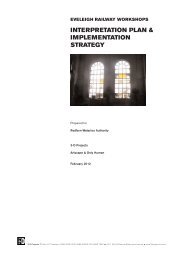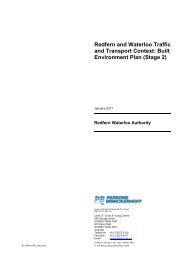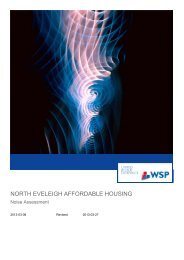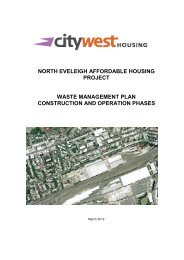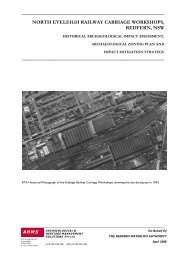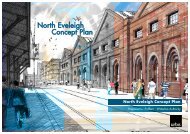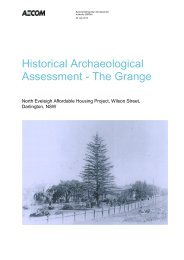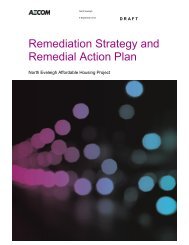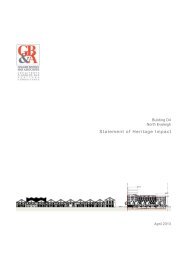here - SMDA - NSW Government
here - SMDA - NSW Government
here - SMDA - NSW Government
Create successful ePaper yourself
Turn your PDF publications into a flip-book with our unique Google optimized e-Paper software.
Financials - Sydney Metropolitan Development Authority<br />
Notes to the Financial Statements for year ending 30 June 2012<br />
(iii) Revaluation of property,<br />
plant and equipment<br />
Physical non-current assets are valued<br />
in accordance with the “Valuation of<br />
Physical Non-Current Assets at Fair<br />
Value” Policy and Guidelines Paper (TPP<br />
07-1). This policy adopts fair value in<br />
accordance with AASB 116 Property,<br />
Plant and Equipment and AASB 140<br />
Investment Property. Information on<br />
investment property is separately<br />
discussed at Note 1(j)(x),<br />
The fair value of land under a prepaid<br />
long-term lease is negligible and as such<br />
is carried in the asset register. However,<br />
land under a prepaid long-term lease,<br />
irrespective of whether upfront lease<br />
income was received, that continues to<br />
receive a rental stream is measured at fair<br />
value as investment property.<br />
Property, comprising land and buildings,<br />
is measured on an existing use basis,<br />
w<strong>here</strong> t<strong>here</strong> are no feasible alternative<br />
uses in the existing natural, legal,<br />
financial and socio-political environment.<br />
However, in the limited circumstances<br />
w<strong>here</strong> t<strong>here</strong> are feasible alternative uses,<br />
assets are valued at their highest and<br />
best use.<br />
Fair value of property, plant and<br />
equipment is determined based on the<br />
best available market evidence, including<br />
current market selling prices for the<br />
same or similar assets. W<strong>here</strong> t<strong>here</strong> is no<br />
available market evidence, the asset’s fair<br />
value is measured at its market buying<br />
price, the best indicator of which is<br />
depreciated replacement cost.<br />
Land and buildings, including open<br />
spaces and roads, are revalued at least<br />
every three years or with sufficient<br />
regularity to ensure that the carrying<br />
amount of each asset does not differ<br />
materially from its fair value at reporting<br />
date. The last revaluation was completed<br />
on 31 May 2012 and was based on an<br />
independent assessment.<br />
Non-specialised assets with short useful<br />
lives are measured at depreciated historical<br />
cost, as a surrogate for fair value.<br />
When revaluing non-current assets by<br />
reference to current prices for assets<br />
newer than those being revalued<br />
(adjusted to reflect the present condition<br />
of the assets), the gross amount and the<br />
related accumulated depreciation are<br />
separately restated.<br />
For other assets, any balances of<br />
accumulated depreciation at the<br />
revaluation date in respect of those<br />
assets are credited to the asset<br />
accounts to which they relate. The net<br />
asset accounts are then increased or<br />
decreased by the revaluation increments<br />
or decrements.<br />
Revaluation increments are credited<br />
directly to the asset revaluation<br />
reserve, except that, to the extent that<br />
an increment reverses a revaluation<br />
decrement in respect of that class<br />
of asset previously recognised as an<br />
expense in the surplus/deficit, the<br />
increment is recognised immediately as<br />
revenue in the surplus/deficit.<br />
Revaluation decrements are recognised<br />
immediately as expenses in the surplus/<br />
deficit, except that, to the extent that<br />
a credit balance exists in the asset<br />
revaluation reserve in respect of the same<br />
class of assets, they are debited directly<br />
to the asset revaluation reserve.<br />
As a not-for-profit entity, revaluation<br />
increments and decrements are offset<br />
against one another within a class of noncurrent<br />
assets, but not otherwise.<br />
W<strong>here</strong> an asset that has previously been<br />
revalued is disposed of, any balance<br />
remaining in the asset revaluation reserve<br />
in respect of that asset is transferred to<br />
accumulated funds.<br />
(iv) Impairment of property,<br />
plant and equipment<br />
As a not-for-profit entity with not cash<br />
generating units, AASB 136 Impairment<br />
of Assets effectively is not applicable.<br />
AASB 136 modifies the recoverable<br />
amount test to the higher of fair value<br />
less costs to sell and depreciated<br />
replacement cost. This means that, w<strong>here</strong><br />
an asset is already measured at fair value,<br />
impairment can only arise if selling costs<br />
are material. Selling costs for the entity<br />
are regarded as immaterial.<br />
(v) Depreciation of property,<br />
plant and equipment<br />
Except for certain heritage assets,<br />
depreciation is provided for on a straightline<br />
basis for all depreciable assets so<br />
as to write off the depreciable amount<br />
of each asset as it is consumed over<br />
its useful life to the Authority. Heritage<br />
assets that have been improved to<br />
provide rental income will be depreciated<br />
in accordance with <strong>NSW</strong> Treasury<br />
guidance, as commercial buildings over<br />
40 years. Estimates of remaining useful<br />
lives are made on a regular basis for all<br />
assets, with annual reassessments for<br />
major items.<br />
All material separately identifiable<br />
components of assets are depreciated<br />
over their useful lives.<br />
Land is not a depreciable asset. Certain<br />
heritage assets including original<br />
artworks and artefacts may not have a<br />
limited useful life because appropriate<br />
curatorial and preservation policies are<br />
adopted. Such assets are not subject<br />
to depreciation. The decision not to<br />
recognise depreciation for these assets is<br />
reviewed annually.<br />
The following depreciation rates were<br />
applied during 2011-12 financial year:<br />
––<br />
Furniture and fittings 4-5 years<br />
––<br />
Plant and equipment 3-4 years<br />
––<br />
Freehold building 5 years *<br />
26<br />
SYDNEY METROPOLITAN DEVELOPMENT AUTHORITY



